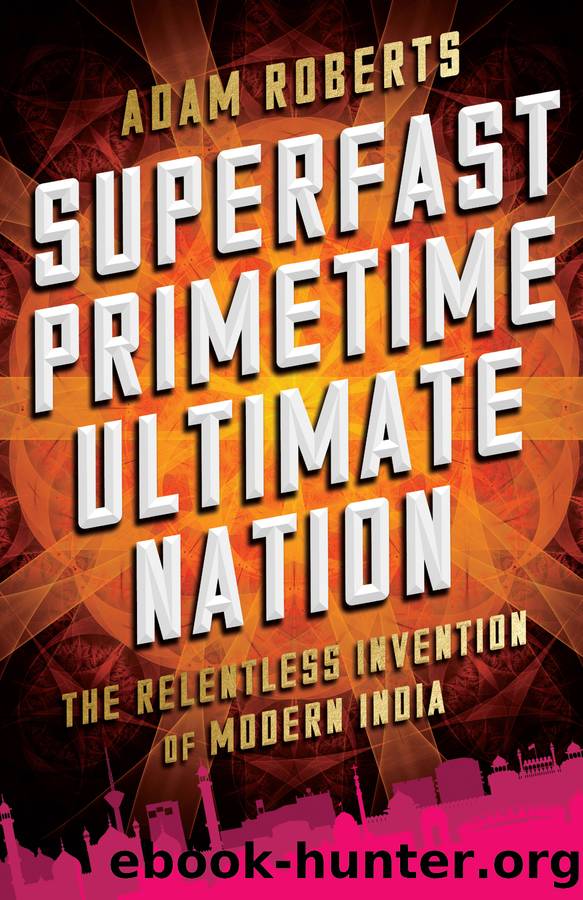Superfast Primetime Ultimate Nation by Adam Roberts

Author:Adam Roberts [ROBERTS, ADAM]
Language: eng
Format: epub
Publisher: PublicAffairs
Published: 2017-04-25T00:00:00+00:00
PART 3
ULTIMATE—ABROAD
LIFTING AN OLD CURSE FROM PAKISTAN
NARENDRA MODI APPEARED TO BELIEVE THAT HIS PERSONALITY and activities were the embodiment of foreign policy, or of the state. His predecessors, by tradition, took office with a relatively low-key ceremony, indoors at Rashtrapati Bhavan, the president’s cream-and-red sandstone palace. Modi organized a much grander affair in 2014, with a huge crowd and a high-kicking show. Bagpipers played and twirled, trumpeters tootled from balconies, tall men in white uniforms lined red carpets. The event had a Disneyfied air of a coronation, set in the sprawling grounds of the palace, the Lutyens centerpiece of colonial architecture from 1929. Sitting near the front in the chuckling company of Gujarati MPs, I was told by one of them how astrology was the best guide for politicians and that “Modi will make India a hundred times stronger.”
Clouds of starlings swooped across the pale evening sky. Men with pikes and knee-high riding boots stood to attention as ministers pledged their loyalty. Most striking, however, were the foreign guests. Leaders from South Asia had formed a group in 1985, SAARC (the South Asian Association for Regional Co-operation), which by 2016 accounted for over one-fifth of the world’s population. But they rarely attended each other’s inaugurations, nor did they act as a meaningful regional body, encouraging trade, cross-border travel, or coordination. There was nothing like the routine gathering of leaders in the European Union, for example. Yet all but one of SAARC’s heads of government came to this event. Mahinda Rajapaksa, then Sri Lanka’s president, flashed a Cheshire Cat grin and Hamid Karzai, the Afghan leader, offered an obsequious bow, followed by leaders from Bhutan, Nepal, and the Maldives. Modi and his guests signaled that the neighborhood was a priority and foreign affairs had become a more pressing concern.
The most notable guest was Nawaz Sharif, Pakistan’s prime minister. Modi was reviled by most in Pakistan as a virulent Hindu nationalist. A Pew Research Center poll in 2015 found that only 7 percent of Pakistanis would trust him. Yet Sharif came, defying both Pakistan’s public opinion and, more significant, its powerful army. Both India and Pakistan had leaders ready to explore a new sort of relationship. As ceremonies wrapped up, Sharif strode toward Modi through a swirl of presidents, royalty, and heads of state and shook his hand demonstratively. The two held their first bilateral meeting the next day. That meeting and subsequent ones in the next two years, in Nepal and in Pakistan, showed them exploring how to move on from decades of awful relations. The men had to get beyond the bitterness of a winter of war in Kashmir in 1947 and 1948, a month-long border war in 1965 (which killed perhaps three thousand Indians and nearly four thousand Pakistanis), war between the countries in 1971 over Bangladesh (during which ninety thousand Pakistanis were forced to surrender and the eastern half of Pakistan seceded), and a brief war in 1999, again in Kashmir. If Pakistanis, especially, were sore about the
Download
This site does not store any files on its server. We only index and link to content provided by other sites. Please contact the content providers to delete copyright contents if any and email us, we'll remove relevant links or contents immediately.
| Arms Control | Diplomacy |
| Security | Trades & Tariffs |
| Treaties | African |
| Asian | Australian & Oceanian |
| Canadian | Caribbean & Latin American |
| European | Middle Eastern |
| Russian & Former Soviet Union |
The Secret History by Donna Tartt(18846)
The Social Justice Warrior Handbook by Lisa De Pasquale(12141)
Thirteen Reasons Why by Jay Asher(8794)
This Is How You Lose Her by Junot Diaz(6794)
Weapons of Math Destruction by Cathy O'Neil(6143)
Zero to One by Peter Thiel(5686)
Beartown by Fredrik Backman(5597)
The Myth of the Strong Leader by Archie Brown(5425)
The Fire Next Time by James Baldwin(5249)
How Democracies Die by Steven Levitsky & Daniel Ziblatt(5128)
Promise Me, Dad by Joe Biden(5087)
Stone's Rules by Roger Stone(5026)
A Higher Loyalty: Truth, Lies, and Leadership by James Comey(4843)
100 Deadly Skills by Clint Emerson(4840)
Rise and Kill First by Ronen Bergman(4703)
Secrecy World by Jake Bernstein(4646)
The David Icke Guide to the Global Conspiracy (and how to end it) by David Icke(4625)
The Farm by Tom Rob Smith(4435)
The Doomsday Machine by Daniel Ellsberg(4416)
